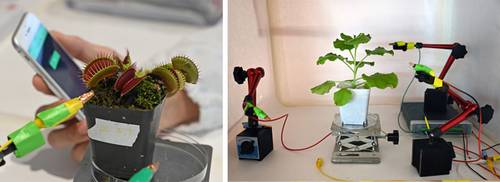Singapore. Talking about carnivorous plants manipulated at a distance or vegetables that warn when they are affected by a disease does not refer to a science fiction film, but to the work of scientists who experiment with new systems to communicate with these beings.
In Singapore, researchers connected plants to electrodes capable of detecting the low electrical signals that plants naturally emit.
They used this technology to make a flytrap dionea close its two-lobed “jaws” when a smartphone emits a signal.
They then attached one of the lobes to a robotic arm to grab a half-millimeter wire and then a small object as it fell.
The technology is in its infancy, but researchers believe that it could serve in the future to conceive “robot-plants” capable of manipulating objects too fragile for the rigid arms of machines.
“These natural robot species could interrelate with artificial ones to create hybrid systems,” said Chen Xiaodong, author of a study published by Nanyang Technological University (NTU) in Singapore.
Many problems remain to be solved. For example, scientists can stimulate the “jaws” of flytraps to close, but are unable to open them, a process that takes 10 hours or more in nature.
The system can also detect weak signals emitted by plants. This could eventually allow farmers to be alerted at an early stage when these beings are sick.
“By monitoring the electrical signals from the plants, we might be able to detect distress calls and anomalies,” Chen said.
“Farmers may realize that a disease is spreading even before clear symptoms appear.”
Scientists have long known about the existence of electrical signals emitted by plants, but their irregular and soft surface makes it difficult to install sensors.
The researchers devised electrodes with a flexible texture that can be adjusted around a plant to detect signals more reliably. They are glued with a thermogel.
Other researchers are going the same way.
In 2016, a team from the Massachusetts Institute of Technology used spinach leaves as detectors capable of sending emails to scientists when explosives were detected underground.
The researchers placed carbon nanotubes that could emit a fluorescent signal when plant roots detected nitroaromatic compounds, a substance often used in explosives. An infrared camera read the signal and sent a message to the scientists.


